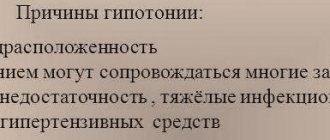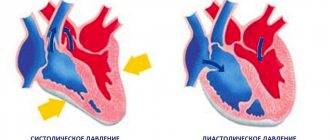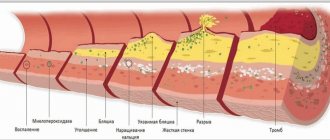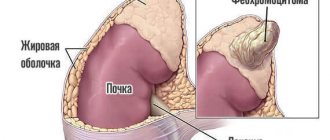Expanding, dull headaches are among the so-called “general cerebral symptoms” that occur in people with brain tumors of various types and locations. They bother approximately 50% of patients, that is, they are among the most common symptoms.
Not all patients experience headaches due to a brain tumor because there are no pain receptors in the gray and white matter. That is, the brain itself cannot hurt. And if the neoplasm is small, non-aggressive and located deep in the accumulation of nerve cell bodies or conducting fibers, then the person does not experience pain for a long time.
When intracranial pressure increases, fluid accumulating in the ventricles of the brain leads to dull, arching pain.
Painful sensations appear when the growing node and the fluid that is formed as a result of the vital activity of tumor cells and accumulates in tissues and cavities begin to compress the cranial nerves, the walls of blood vessels and the meninges - that is, those structures in which there are pain receptors. At the same time, due to an increase in the amount of fluid in a person, intracranial pressure increases, which may be evidenced by certain changes in the fundus of the eye.
How cancer affects blood pressure
A malignant tumor formed in the human body changes the metabolic processes that occur in the body. As a result of this restructuring, pressure begins to jump, thanks to the maintenance of which at a certain level the tissues are supplied with both oxygen and nutrients.
With oncology, low blood pressure levels often return to normal on their own or rise sharply. With significant blood pressure, the vessels are not able to withstand the load and rupture. Hypotension is fraught with the development of oxygen starvation. When blood pressure decreases, a person with cancer experiences nausea, increased heart rate, and dizziness.
Often the patient faints; in the presence of metastases and the absence of urgent help, he no longer recovers, but dies.
With a malignant tumor, blood pressure drops because the body is poisoned and hypoxia occurs. As the tumor increases in size, the composition of the blood changes, blood vessels are compressed, nutrients and oxygen do not reach the heart muscle, and the intensity of its contractions decreases.
conclusions
Cancer patients often suffer from low blood pressure. It is caused by exhaustion of the body, the development of hidden arrosive bleeding and the toxic effect of cancer cells.
Hypertension develops against the background of a neoplastic process when a tumor grows into the walls of blood vessels and compresses their lumen from the outside. In mild cases of the disease, it is absent. Increased blood pressure is typical for tumors of the adrenal glands, pituitary gland, and thyroid gland.
Low blood pressure is only one of the symptoms of the cancer process. Temporary drug correction is possible, but the most effective will be to reduce the tumor mass in the body.
Normal blood pressure readings in cancer patients
A person suffering from the presence of a malignant tumor often faints because oxygen starvation occurs. Pressure parameters must be constantly monitored; their increase or decrease indicates that the patient’s condition is deteriorating. The upper norm is 120 millimeters of mercury. The systolic value reflects the maximum contraction of the heart at the moment blood enters the aorta.
When the muscle relaxes completely, the tonometer records the lower parameter - diastolic pressure. In a healthy person, its value should be within 80 millimeters of mercury. In a cancer patient, the heart rate is considered normal when the device reads 120/80; only a minimal deviation in one direction or another is allowed. An upper value of 100 millimeters of mercury indicates the presence of hypotension.
Associated symptoms
In a third of patients, bursting pain and a feeling of pressure on the eyeballs from the inside become the first symptoms that they pay attention to. As the disease progresses, these disturbances in well-being may be accompanied by other cerebral manifestations (dizziness, nystagmus), as well as focal symptoms.
For example, people with tumor lesions of the cerebellum experience unsteady gait and difficulty coordinating movements. In patients with tumors localized in the area of the speech center, speech is impaired. When the visual tuberosities are compressed, patients complain of double vision, loss of visual fields, distortion of the perception of surrounding objects, “primitive” visual hallucinations (photopsia), etc.
Glowing spots before the eyes (photopsia) is a symptom accompanying headaches that occurs when a tumor compresses the visual tuberosities
The presence of a lesion in the parietal lobe leads to a decrease in intelligence and disruption of thought processes, in the frontal lobe - to the development of depressive states, loss of the ability to plan and make decisions.
It should be added that all of the above manifestations, including specific signs characteristic of headaches with brain tumors, cannot serve as a basis for making a final diagnosis. After all, similar disturbances in well-being accompany various infectious processes and can appear with a carotid artery aneurysm and other non-oncological diseases.
However, if the patient notes:
- Changing the nature of headaches;
- Expanding, pulsating, worsening when bending or turning the head;
- Night GB;
- Hypertension resistant to drug therapy;
- headache with focal neurological symptoms characteristic of damage to certain brain structures (for example, disturbances in motor function, vision, hearing, speech, memory, attention, intelligence, emotions, or the appearance of abnormal sensations, visual or auditory hallucinations);
- headaches accompanied by general cerebral symptoms associated with increased intracranial pressure: repeated vomiting, dizziness, convulsions or weight loss,
then a series of diagnostic studies are prescribed. Based on the results obtained, the true cause of the ailment is determined and a treatment plan is drawn up. Doctors obtain the most complete and reliable information by scanning the brain using magnetic resonance imaging using modern high-field tomographs.
Tomograms obtained using MRI scans of the brain allow the doctor to accurately determine the nature of the problems
Causes and symptoms of low blood pressure in cancer
If a malfunction occurs in the body of a person who has been diagnosed with a cancerous tumor, and the blood flow is no longer able to supply oxygen and nutrients to the tissues, this indicates that the patient has low blood pressure.
The reasons for its fall include:
- Dehydration of the body. A person loses fluid due to vomiting and diarrhea that accompany cancer.
- Internal bleeding. A growing tumor damages tissue, circulation slows down, which can lead to death.
- Infectious infection. The immune system of a person suffering from cancer is unable to fight germs. Due to the decline in vitality, blood pressure decreases.
To stop the development of cancer and destroy abnormal cells, treatment is carried out using strong chemicals that have a negative effect on the entire body, on the bloodstream.
If the pressure drops, the patient experiences tinnitus and dark vision. He is rapidly weakening, complaining of dizziness, nausea, lack of air, and loss of ability to work.
A decrease in diastolic pressure leads to neurosis, anxiety, sudden changes in mood, irritability or apathy. In severe cases, the patient faints.
How does a headache with a brain tumor hurt?
HD may have features that doctors call “red flags”—signs more typical of neoplasms or metastatic disease of the brain.
First of all, such pain is constant. Neither painkillers nor sleep can save you from them. Moreover, the headache is most severe after a night's sleep, and only after a few hours the pain becomes a little less painful. This is explained quite simply. The fact is that in a lying position, the outflow of accumulated fluid from the cavities of the brain is hampered, which leads to its stagnation. Accordingly, the person’s intracranial pressure increases even more, and the pain intensifies. After the patient takes a horizontal position (sits down or stands up), the outflow of fluid is facilitated, it gradually flows into the spinal cord canal, the pressure on the walls of the ventricles of the brain decreases and the pain decreases.
Often painful sensations are accompanied by vomiting. Unlike vomiting that occurs as a result of poisoning, it does not bring relief to the patient: nausea and vomiting persist.
At a certain location of the tumor, the pain can be pulsating.
Similar symptoms are observed during a migraine attack, but headaches with a brain tumor are much stronger.
The headache may become more painful when changing body position or when coughing, as well as during physical activity.
High blood pressure in cancer - causes and signs
The presence of hypertension increases the likelihood of death in a cancer patient. Hypertension occurs due to the fact that a malignant tumor develops rapidly and puts pressure on the vessels, and the lumen in them narrows greatly. Blood flow is disrupted, the work of the heart muscle becomes more difficult, and blood pressure increases.
When its parameters increase in a patient suffering from cancer:
- The face turns red and swells.
- Dark dots flash before my eyes.
- I have a headache.
- Eyelids swell.
- Blood is flowing from the nose.
An increase in pressure is observed with oncology of the intestines, kidneys, and in the presence of a malignant tumor in the bladder. Indicators also increase due to the fact that a person worries about the presence of cancer.
How to deal with the problem?
High blood pressure in oncology is often caused by disturbances in the structure of the organ due to the germination of its functional part by pathological tissue. Such changes in blood pressure can only be corrected etiotropically (by influencing the cause):
- if the vessels are compressed from the outside, surgical removal of the tumor mass or local radiation therapy is necessary, which will reduce the volume of the tumor;
- when the walls of blood vessels grow, blood pressure will be reduced by the elimination of cancer cells from the body (targeted or chemotherapy, radiation);
- if the kidney parenchyma is affected by metastases, they must be excised or reduced in size as much as possible in a conservative way;
- in case of a brain tumor it is necessary to remove it;
- if endocrine organs are affected, medications that block the effects of hormones will provide temporary relief.
High blood pressure can be caused by hormonal treatment of a tumor (for example, prostate cancer).
In turn, low blood pressure in oncology is characterized by changes caused by the indirect influence of the tumor and arrosive bleeding. Oncologists prescribe symptomatic treatment (drugs to increase blood pressure, hemostatic agents), but this is a temporary measure that supports the patient’s life while preparing for surgery.
Methods of normalization at home
It is impossible to cure cancer on your own, to determine why the blood flow is disrupted, but it is quite possible to alleviate the condition by normalizing the blood pressure.
If a person has cancer, there is no need to constantly think about the disease, thinking that this is the end. Bad mood and psycho-emotional stress only aggravate the situation. When a person is calm and not nervous, he feels better. A balanced diet is equally important for a cancer patient.
The diet should be dominated by foods rich in vitamins and microelements, in the form of:
- potassium;
- magnesium;
- calcium.
Pumpkin seeds, fruits, parsley, and bran bread help normalize the condition. It is advisable for the patient to consume a minimum of salt, give up alcohol and coffee, drink no more than one and a half liters of liquid, and do not smoke.
Not everyone knows what to do when they feel dizzy or feel very nauseous. Short-term relief comes if you eat a small piece of lard, walnuts or peanuts, drink a cup of strong tea, sweet coffee, or put salt on your tongue.
It is worth using one of the folk recipes, which helps normalize blood pressure not for an hour, but for a long period:
- Pour a pinch of mustard into a glass of boiling water.
- Add 2 tablespoons of bee honey to the infusion.
- The medicine is taken in the morning and evening before meals.
Acupressure helps relieve hypotension in a cancer patient. The specialist influences the central part of the back of the head, the big toe, the nail of the little finger, the area of the nasolabial fold and the carotid artery.
Kneading movements between the shoulder blades, rubbing the knees, abdomen, and ankles not only help eliminate hypotension, but also restore a person’s vigor and good mood.
Prevention of pressure surges in a patient with oncology
The following tools will be useful:
- minimizing nervous shock (relatives should learn to provide information about the course of the disease);
- dietary restrictions (the daily amount of salt should not exceed 5 g);
- fluid intake up to 1.5 liters per day;
- exclusion of substances that excite the nervous system: alcohol, coffee, strong tea, nicotine.
If necessary, the doctor will prescribe maintenance drug therapy.











